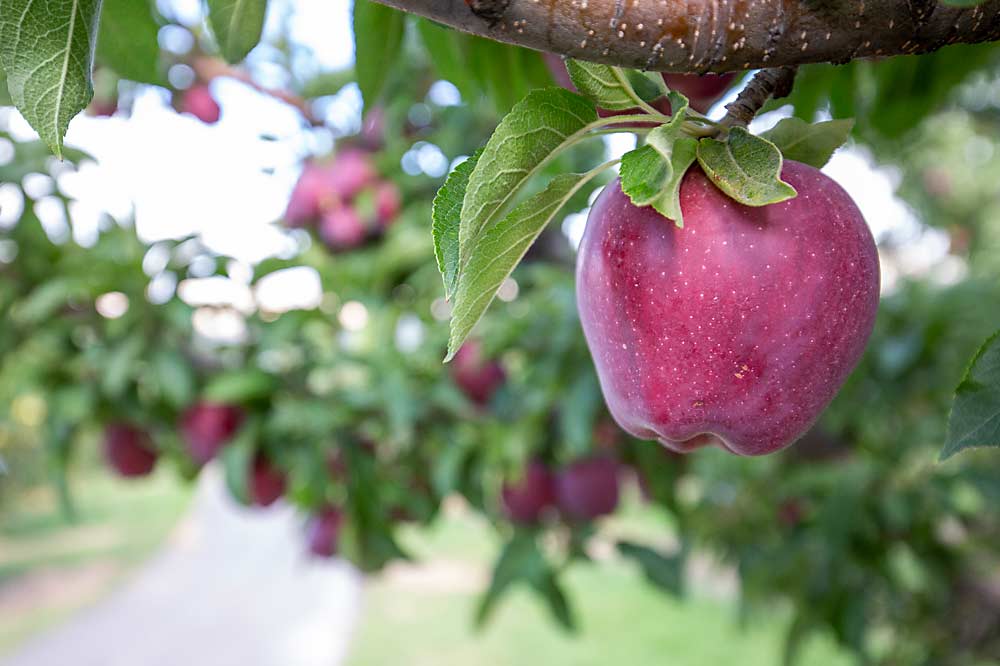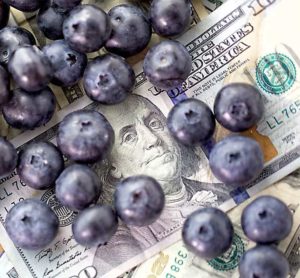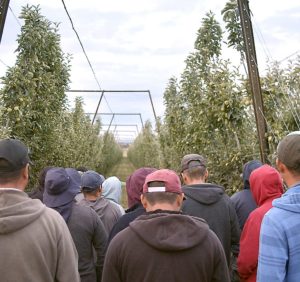
Earlier this year, federal officials priced the job of picking Red Delicious apples in Washington at over $28 per bin.
That’s quite a jump from the 2021 prevailing wage of $20 per bin for Reds, because the 2022 wages published in January by the U.S. Department of Labor consolidate all apple harvesting, except Cripps Pink and Honeycrisp ($30 and $31.76 per bin, respectively), into one category.
Those findings have tree fruit industry officials once again questioning the validity of Washington’s agricultural prevailing wage survey, while recently unsealed legal documents show the generic apple harvest category stems from agreements made between wage regulators and worker advocates who challenged them in court — without industry representation.
Brendan Monahan, an attorney who represents tree fruit groups and employers, is asking state and federal labor officials to share details of how they come up with prevailing wages, including the harvest of Washington’s lowest-value variety.
The prevailing wages for harvesting Honeycrisp and Cripps Pink apples are plausible, based on their high value, Monahan said. But the 2022 prevailing wage list mentions only one other apple harvest category, a generic “apple” for $28.26 per bin. Thus, harvesting high-value apples such as Cosmic Crisp and Opal would be paid at the same rate as Red Delicious, the state’s lowest-value variety.
“Nobody can pay that — and historically, there’s zero chance anybody has paid that,” Monahan said of Red Delicious harvest.
By comparison, the USDOL’s 2017 agricultural wage library listed 16 different varieties by name for harvest, even rare cultivars such as Ginger Gold and Scifresh, but no generic apple category. In 2016, the wage library included a category titled “All Other Apple, Harvest” but no finding, while 10 varieties made the list by name, each with a unique prevailing piece-rate wage.
Many growers say prevailing wage surveys artificially drive up labor costs, turning the wages they pay to stay competitive one year into the following year’s floor. And, if they don’t understand how their data is used, they hesitate to respond to the voluntary questionnaire. But without broad participation, the surveys won’t accurately reflect going rates, creating a Catch-22.
Prevailing wage 101
Wages published in January attracted extra scrutiny.
The USDOL requires states with industries that contract H-2A workers to conduct an annual Agricultural Peak Employment Wage and Practice Employer Survey, as part of the federal government’s mandate to prevent foreign workers from driving down the wages of domestic workers. The primary tree fruit states — Washington, Michigan, New York, Pennsylvania, California and Oregon — fall into that category.
The USDOL contracts state workforce agencies — in Washington’s case, the Employment Security Department, or ESD — to conduct the surveys under regulations found in a document called Handbook 385, which predates the H-2A program. At the urging of employers, states have embraced nuances of farming and list prevailing wages in subcategories — called “commodity activities” — based on regions, variety, market and horticultural practices such as color picking, tree density and stem clipping.
Based on those surveys, the USDOL issues prevailing wages for categories in which it has enough data to draw conclusions. H-2A employers are required to pay whichever is the highest of those prevailing wages, the state or federal minimum wage, a collective bargaining contract wage or the Adverse Effect Wage Rate (AEWR) — a regionalized hourly rate based on a different survey conducted every year by the U.S. Department of Agriculture.
Employers have long argued that AEWR and prevailing wages bake leapfrogging labor costs into wage survey findings. Labor advocates counter that more data — and more grower participation — would yield more accurate wage rates.
To validate statistics, the federal government requires a threshold of participants, usually representing 15 percent of a state’s total estimated peak number of workers. If that is not met, employers in that state must then pay at least the next highest wage, usually AEWR.
Washington lawsuit
In 2016, at the request of some employer groups, the Washington ESD began asking growers if they offered workers an “hourly guarantee,” as well as piece-rate pay, the standard historical practice in the fruit industry.
Worried this would artificially drive down wages, Columbia Legal Services and Familias Unidas por la Justicia sued the ESD and USDOL to challenge the validity of the 2019 survey on behalf of Ramon Torres Hernandez, a Yakima County, Washington, tree fruit laborer. Judge Sal Mendoza ruled in Torres Hernandez’s favor, calling that survey “arbitrary and capricious” and ordering the agencies to revert to the 2018 wages until they could conduct a new survey.
As a result, in the 2021 survey, the state continued to ask about an hourly guarantee, but the term has been better defined and cannot be used synonymously with minimum wage or AEWR, said Andrea Schmitt, Columbia Legal Services attorney.
Negotiations in the case are ongoing, but in mid-August, some court records were unsealed. A joint motion filed in late 2021 shows all parties agree that only setting prevailing wages in such granular categories leaves “the majority of workers who harvest apples in Washington unprotected by a prevailing wage unless the general ‘apple harvest’ wage applies.”
As of the end of June, growers were paying 2022 wages based on the ESD’s 2020 survey, which still used hourly wage language that predates the lawsuit. ESD’s report shows that 44 percent of employers and 54 percent of workers responded to the survey, encompassing 129 commodity activities, 19 of which could meet federal thresholds for publication, including just three for apple harvest: apple, Cripps Pink and Honeycrisp.
How is the sausage made?
Monahan’s law firm, Stokes Lawrence in Yakima, has formally requested that the state ESD and USDOL share raw source data for the survey and communications between the agencies and Columbia Legal Services, to scrutinize the methodology. In early August, the law firm received some emails between lawyers for all the lawsuit’s parties, but they were heavily redacted.
“Washington has been the most dogged and creative in deciding whether they reach those (wage category) thresholds, and it’s in secret,” Monahan said.
Meanwhile, the $28.26 per bin wage may soon change. The ESD has submitted its new survey results, based on the post-lawsuit revamp, to the USDOL. But as of Good Fruit Grower’sAugust press deadline, the federal government had not updated the wage library. Industry officials were unclear what that meant for current prevailing wages. Thomas Silva, Seattle district director for the USDOL, directed questions back to the state workforce agencies.
Either way, Monahan’s firm is asking for more documents with fewer redactions. The Washington State Tree Fruit Association supports that effort, said Jon DeVaney, president of the Yakima organization that represents tree fruit employers.
Media representatives at ESD responded by email to questions from Good Fruit Grower, though several requests for phone interviews went unanswered. The ESD’s labor market information director position is vacant.
“We don’t have anything else to add in an interview,” the emails said.
In those emails, the agency denied combining commodity activities to come up with findings but defaulted to a more general term this year, without a variety-specific rate.
“ESD does not combine categories when we don’t get enough participation in variety categories. The participation threshold was met for a prevailing wage rate of $28.26 per bin for general apple-harvesting. The order simply states that employers must offer the general applicable rate where no variety rate exists for USDOL to approve their H-2A application,” a representative said.
It appears to be a change in how the wage surveys are applied, but not in how they are collected or calculated.
“ESD has not altered or made substantial changes to data collection, administration or tabulation procedures regarding the survey,” a representative also said. “Every year, there are commodity activities that drop from the list or new ones that get added,” based on survey responses.
USDOL ultimately determines what is published.
As for secrecy, the ongoing lawsuit prevented the ESD from following its normal public participation process, a representative said. Usually, ESD gives industry representatives a week to review the results and discuss them in a conference call with agency officials, and then they have another week to file comments before the results are sent to the USDOL. The agency followed that process with the 2021 results.
Watching Washington
Farm Bureau officials in New York and Michigan would like similar insight into the prevailing wage tabulation and are watching Washington’s saga.
Their specialty crop growers receive prevailing wage surveys, too, but end up with “no findings” even more often than Washington. Michigan has not had an apple harvest finding since 2013, according to the USDOL wage library. New York had no apple or pear findings in 2022 and only one in 2021 — 78 cents per bushel to pick apples destined for processing.
State workforce agencies have discretion with how they draft surveys and are under pressure to come up with findings, said Craig Anderson, agricultural labor safety specialist for the Michigan Farm Bureau.
Theoretically, employers are only supposed to report wages paid to domestic workers, but that can be hard to parse out with the increasing reliance on H-2A labor. The market also plays a role. Local labor is scarce enough that growers could not get away with low wages, regardless of the rules.
“The entire structure here was formulated to meet a need that simply no longer exists,” Anderson said.
Worker advocates contend the solution is more survey information, not less. Schmitt, of Columbia Legal Services, said growers could solve these problems themselves simply by filling out the surveys more often. Had more Washington Red Delicious growers participated, she said, the wages they don’t like “might well be lower.”
Prevailing wages occasionally go down. In 2021, the prevailing wage for pruning pears in Washington was $15 per hour. This year, it’s $14.50. In 2019, blueberry picking jumped from 50 cents per pound to 75 cents. This year, it’s back down to 50 cents.
The tree fruit industry counters that the muddy waters dissuade participation.
“A process that no one understands is not one that most people want to participate in,” said DeVaney of the Washington State Tree Fruit Association.
—by Ross Courtney








Leave A Comment